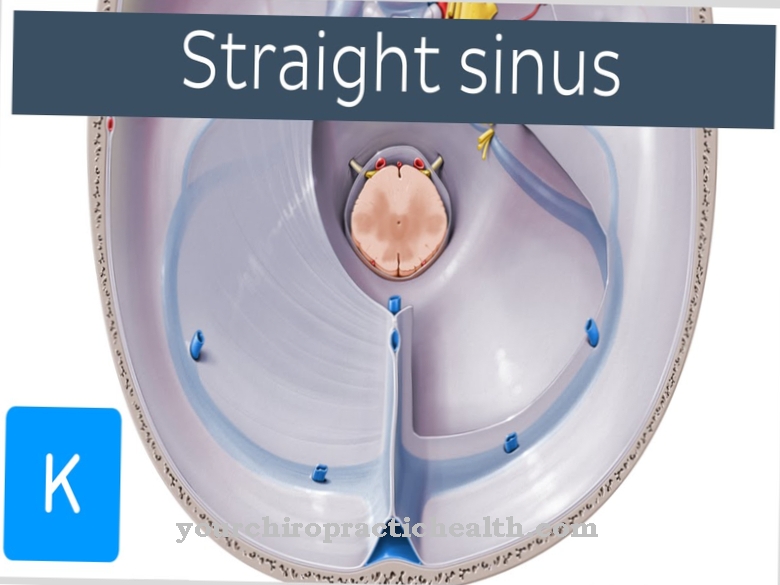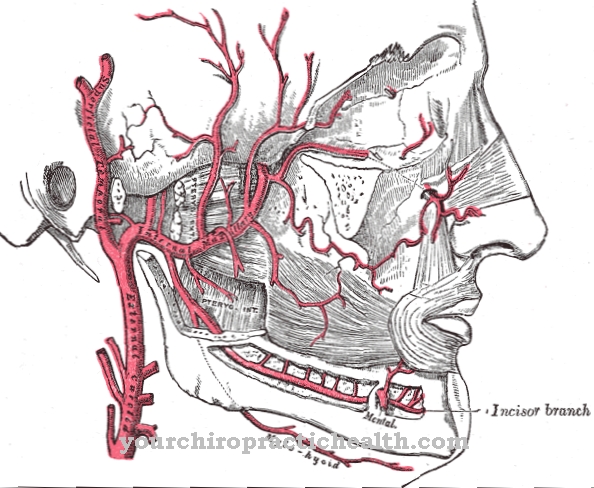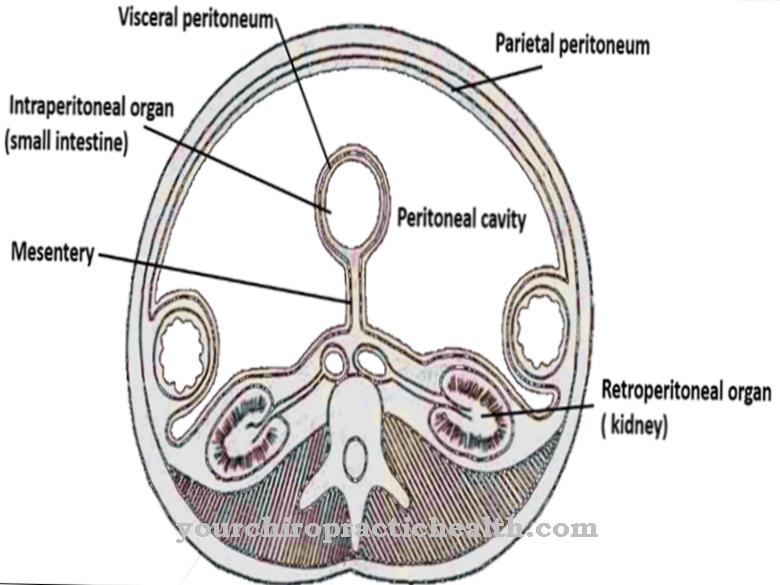One of the numerous blood vessels in the human head is the Sublingual arterywhich has its origin in the lingual artery (arteria lingualis). It ensures the blood supply to the floor of the mouth and the salivary glands. Isolated injuries to the sublingual artery can occur, for example, when a tongue piercing is pierced, the extent of this complication depending on the specific damage.
What is the sublingual artery?
The sublingual artery is an artery that runs through the human head through the area of the lower jaw. It branches off from the lingual artery, which is also known as the tongue artery and to which the Latin name of the sublingual artery refers: It is located below ("sub-") the larger artery and below the tongue ("lingua").
In addition to the sublingual artery, the lingual artery has three further branches, which are the deep lingual artery, the dorsal lingual artery and the suprahyoid branch. The sublingual artery arises in turn from the external carotid artery (Arteria carotis externa), which is one of the most important blood vessels in the head and neck.
Anatomy & structure
The sublingual artery appears as a branch of the lingual artery. At the hyoglossus muscle, a tongue muscle, the sublingual artery branches off from the larger blood vessel. From there, it moves past the mylohyoid muscle to the salivary gland (sublingual gland), which is located in the lower jaw under the tongue. Then the sublingual arteries of the right and left sides converge.
As with all arteries, the wall of the sublingual artery consists of three layers. The tunica externa or tunica adventitia embodies the outermost layer and, in larger arteries, also contains the vasa vasorum, which is responsible for supplying the vessel walls. Under the tunica externa is the tunica media, which contains collagen and elastic fibers as well as the muscles of the artery. These ring-shaped muscles are used to control blood flow and are able to narrow or widen the vessel. Finally, the tunica intima forms the innermost layer of the artery.
Towards the interior, it is lined with a layer of endothelial cells. They can act on coagulation processes and serve as blood-tissue barriers, whereby they allow an exchange between the substances to a small extent. In addition, the endothelial cells participate in regulating blood pressure and vascular tone.
Function & tasks
The task of the sublingual artery is to supply blood to the salivary glands in the lower jaw, the gums and the floor of the mouth. In the floor of the mouth, the muscles rely on energy, oxygen and other nutrients from the sublingual artery.
The muscles of the floor of the mouth are also known as the upper hyoid muscles or the suprahyoid muscles and belong to the striated skeletal muscles. It consists of the digastricus, geniohyoideus, mylohyoideus and stylohyoideus muscles. These muscles are involved in swallowing on the one hand and in opening the jaw on the other, with the individual muscles working together in a coordinated manner.
In addition, the sublingual artery also supplies the oral mucosa, which is also part of the floor of the mouth. The different cells of the epithelium perform different tasks and vary in terms of their structure: The oral mucosa on the floor of the mouth belongs to the lining of the oral mucosa and is not cornified. Its structural properties give this layer a high level of elasticity, which the oral mucosa of the floor of the mouth requires due to the chewing movements and the associated mechanical stress.
Receptors for sensitive perception are also located in the oral mucosa to absorb pain stimuli, temperature and pressure sensations and to pass them on via the peripheral nervous system. Horny plates do not appear in the lining of the oral mucosa, but in the masticatory oral mucosa, while cells of the specialized oral mucosa participate in gustatory activity.
Oxygen-rich blood from the sublingual artery is vital for the cells: If the blood supply is interrupted for a long time, the cells can therefore die. Among other things, they need oxygen to produce chemically bound energy in the form of adenosine triphosphate (ATP). In aerobic respiration, the body uses oxygen to oxidize glucose to make the ATP. The energy carrier is then available to the cell for numerous metabolic processes.
You can find your medication here
➔ Medicines against tartar and tooth discolorationDiseases
Because the sublingual artery is a small blood vessel, isolated injuries that do not involve other structures in the head are rare.
However, a lesion that only affects the sublingual artery is possible with a tongue piercing. Often the tongue swells immediately after the sting. Other complications associated with sticking a tongue piercing include damage to other blood vessels, nerve tracts, gums, and teeth. Problems with swallowing, biting, inflammation, infections due to insufficient sterilization and allergies are also conceivable. Serious complications are generally considered rare; In individual cases, however, an injury to the blood vessels of the tongue can lead to profuse bleeding with considerable blood loss.
Bleeding from the sublingual artery may affect the muscles that rely on blood vessel supplies. These muscles are the suprahyoid muscles that are active when swallowing and opening the jaw.
Tongue carcinomas around the sublingual artery may affect the blood vessel. Tongue cancer is a new growth that is usually malignant and is a form of cancer. Various factors influence the development of tongue cancer; it is more common with alcohol, nicotine, and oral drug use, and can develop in different places on the tongue.
























.jpg)



